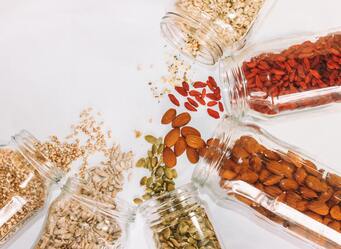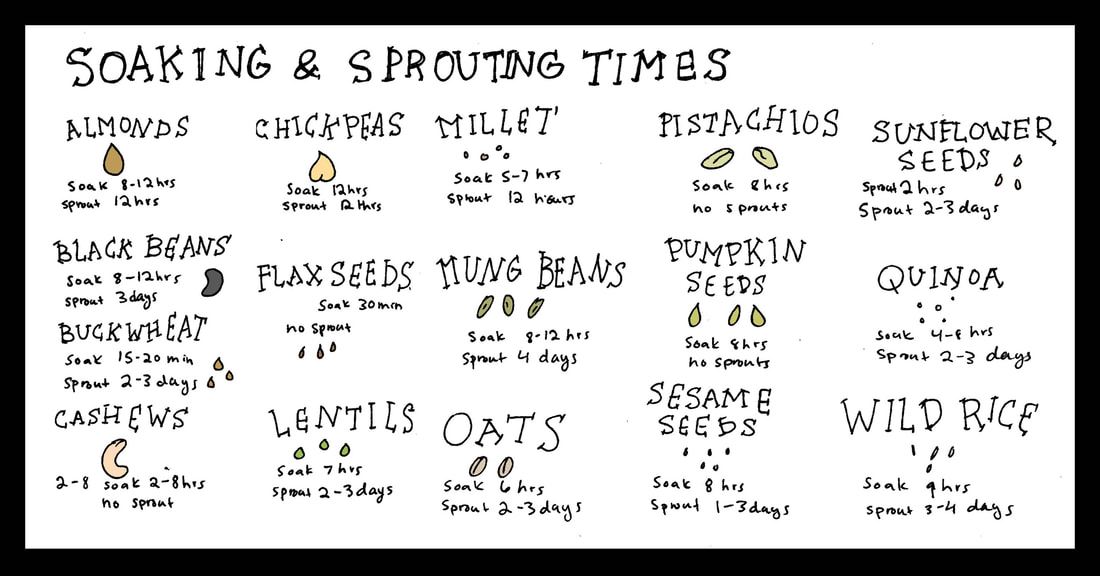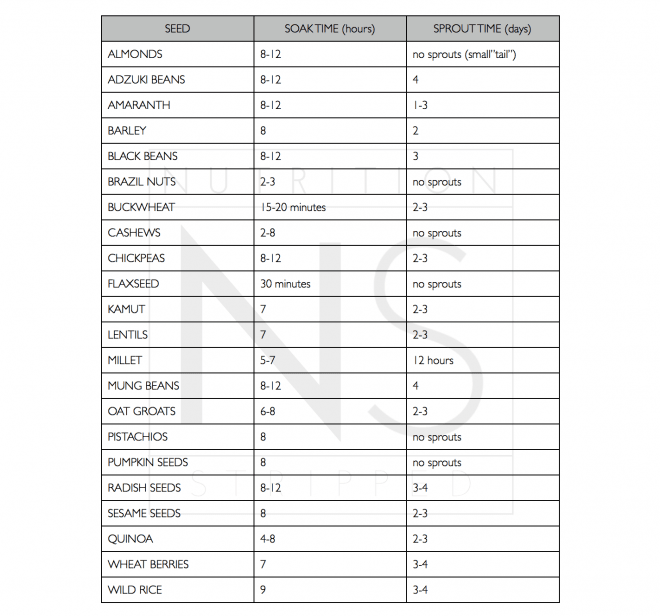 Consuming plant-based foods is a foundation for a healthful diet and promotes optimal wellness. However, many of us are actually blocking our nutrient absorption by consuming anti-nutrients such as phytic acid. The good news is that decreasing phytic acid in these nutritious foods is actually quite simple! To get the most from each bite, soaking OR soaking and sprouting, are two methods to increase the nutritional value of some plant foods including nuts, seeds, dried legumes, and grains. It may take a moment to learn this simple method. Rest assured, you will soon be like the millions of others that wished they had learned this sooner! Below are simple preparation tools to improve nutrient absorption, promote improved digestion, and increase nutrient density (1). Hard to beat! Here is some of science behind this method: 1. Nutrient Accessibility: There are certain substances naturally found in foods that inhibit or make it harder for our bodies to get the maximum nutrition from the plant. Phytic acid is one of these compounds. Soaking and sprouting raw, whole or uncut nuts, seeds, dried legumes, and grains is advantageous because it helps break down the phytic acid for us, improving the availability of key nutrients like calcium, iron, and zinc for the body to absorb more easily (1). 2. Improving Digestion: There are so many different types of legumes including beans, lentils, and peas (2). Legumes are packed with nutrition providing protein, healthful carbohydrates, dietary fiber, vitamins, and minerals (3). However, in addition to phytic acid, legumes contain oligosaccharides, a type of carbohydrate that can be harder for some people to digest causing gas, bloating, and belly discomfort. Good news though, the process of soaking removes some of these oligosaccharides making it easier for the belly to digest these healthful foods (1). 3. A Boost of Nutrient Density: Sprouting is the process of soaking, draining, rinsing, and leaving seeds to germinate and begin to sprout - recreating the process of “watering” a plant and helping it grow (4)(1). Sprouted plants have been found to be SUPER nutrient-dense and packed with nutrition like vitamins (1). Research shows that sprouting plant foods like legumes enhances nutrient bioavailability (making access to the nutrient easier) and improves digestibility. In one study, the process increased protein and vitamin C while reducing nutrient inhibitors making the selected legume easier to digest and offering more nutrients for the body to absorb (5). Another study, focused on sprouting whole grains, found that in the right conditions, many nutrients were fully available for the body to access and some antioxidants even occurred at higher concentrations than their non-sprouted counterparts (6). These are just two examples of published research, but there are so many more! Sprouting is an excellent and inexpensive way to boost nutrition of nuts (like almonds and walnuts), seeds (like pumpkin and sunflower seeds), dried legumes (like chickpeas and lentils), and grains (like buckwheat, wheat berries, and quinoa) as well as as store bought sprout seeds (seeds designed for sprouting rather than planting - some examples include mung bean seeds, alfalfa, radish, and broccoli seeds) (1)(7). So now that we know the amazing reasons WHY we should soak and sprout, let's learn about the process. You'll notice that each food you soak OR soak and sprout will have a little bit of a different process and time recommended. I have included some helpful charts below for your use. Step One is soaking. Please note, if you plan to sprout rather than just soaking, you will need a sprouting jar or mason jar with screen. You can purchase a screen to add to a standard mason jar rather than buying a sprouting jar. For just soaking, you can use a large glass or stainless steel bowl, wide mouth glass mason jar, or sprouting jar. After washing the vessel, pour in the nut/seed/legume/grain. There is no specific amount of food ingredient that you are required to use as long as there is enough room for fresh water to completely cover everything and leaving 1-2 inches of room at the top of the vessel (1). Friendly reminder that sprouts are going to get bigger as they grow so start with a smaller portion until you get used to your size jar. Cover your ingredient with clean or filtered water, put on jar lid or cover with a towel, and set aside in a cool spot out of direct sunlight. Avoid soaking and sprouting in a warm or hot area to help prevent bacterial growth. **For soaking nuts or seeds, add 1/4 tsp of salt per 32 oz of water. **For soaking grains, add a splash of apple cider vinegar or lemon. Step Two is letting your selected food soak in the water. Friendly reminder to remember or write down what time you started soaking and to check a list to see how long the particular food is recommended to soak as each food requires a different amount of time. One you get going with this, you won't need to check the list! Step Three: Remove any floating seeds, pour out old water with a strainer or via the top of the sprouting jar or mason jar with screen, and thoroughly rinse the food item with fresh water. You may need to drain and rinse with clean water a few times until the fluid is clear. At this point, you have completed soaking, are getting all of the benefits of soaking, and are ready to make awesomeness like nut/seed “milk” or crunchy dried nuts (see below for instructions on how I like to dry my soaked nuts). If you would like to sprout, continue to step four. Step Four is sprouting. From here, you will rinse the item with fresh water, drain, and place in a cool spot out of direct sunlight several times a day (3-4 times is recommended) for the duration of time listed for that food. Some foods take 1-2 days while others can take up to a week to fully sprout. Pro tip: jar upside down in the drying rack at a 45-degree angle to support drainage and air circulation (1)(7). Step five is to grow your sprouts to your desired size. The charts below can help with timing. Please note, many sprouted items will grow a little “tail” or sprout greens which are both great signs. But some plants like pumpkin seeds do not grow a tail so do not get discouraged. Soaking and Sprouting Times: Image source: Nutrition Stripped Step 6 is storing your sprouts. After sprouting, dry your sprouts thoroughly in a salad spinner, clean towel, or paper towel. Some people prefer to store sprouts wrapped in mesh cheesecloth or a nut milk bag while others prefer a plastic bag or sealed container. (1)(7). Sprouts should be consumed within 3-4 days to ensure maximum nutrition and safety. Important Safety Note: While sprouts provide loads of health benefits, it is imperative to know that raw or lightly cooked sprouts are vulnerable to harboring bacteria such as E. coli and are at risk for contamination from a food-borne illness and therefore may not be safe for high-risk populations like very young children, the elderly community, pregnant women, and persons with compromised immune systems. Keep hands, jars, and surfaces clean. Make sure to properly refrigerate sprouts. Immediately discard sprouts that have a musty smell, discolored in appearance, or are slimy. Do not consume sprouts past 3-4 days after sprouting. Cooking sprouts thoroughly kills bacteria and significantly reduces illness risk. Ideas for enjoying sprouts:
Resources:
Kooienga, Mckel, MS, RDN, LDN. (2020, August). How to Use Soaking and Sprouting (And why it is beneficial!). Found on www.nutritionstripped.com. 2. Legume Pulses. List of Legumes. 3. Mayo Clinic. Beans and other legumes: Cooking tips - Mayo Clinic. 4. Lou, Yuwei & Xie, Weihua. (2014, December). Effect of soaking and sprouting on iron and zinc availability in green and white faba bean (Vicia faba L.). J Food Sci Technol. Found on Pubmed. 5. Chingakham Basanti Devi, Archana Kushwaha, and Anil Kumar (2015, October). Sprouting characteristics and associated changes in nutritional composition of cowpea (Vigna unguiculata). J Food Sci Technol. Found on Pubmed. 6. Paolo Benincasa, Beatrice Falcinelli, Stanley Lutts, Fabio Stagnari, and Angelica Galieni. (2019, February). Sprouted Grains: A Comprehensive Review. Nutrients. Found on Pubmed. 7. Boulder Locavore. Growing Sprouts & Homemade Sprouting Jars {tutorial}.
2 Comments
2/14/2021 09:56:27 am
Reply
10/21/2021 07:24:21 pm
I like how you mentioned that the sprouting method for nuts increases its nutritional value. My cousin mentioned to me last night that her girlfriend loves to eat walnuts and asked me if I have any idea what is the best option to buy for her. Thanks to this informative article and I'll be sure to tell him that he can try the healthy sprouted walnut that I know.
Reply
Leave a Reply. |
Mitten's BlogCheck out my blog for day to day useful self and and family nourishment and wellness guidance. Categories
All
Archives
March 2023
|
|
Journey to Wellness © 2018
Based in Boulder, Colorado Helping people heal globally Website designed with love by Kelly McClelland |



 RSS Feed
RSS Feed